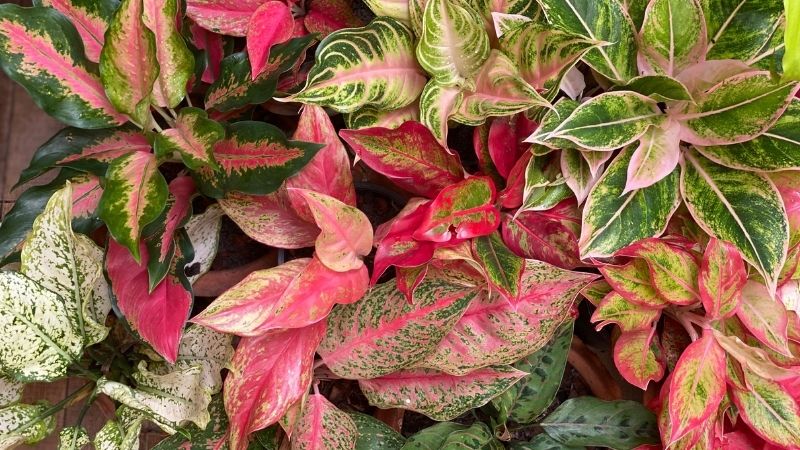How to Care for Aglaonema Plants
Plant Guide

Remarkably few plants rank higher on the easy to care for house plant list than the Chinese Evergreen or Aglaonema. This is partly due to its native habitat, growing under the dense forest canopy of sub-tropical Asia and the Philippines. Aglaonema makes a perfect indoor plant because it tolerates low light so well. In fact, aglaonemas thrive in it.
Aglaonema also does well in bright spots and can tolerate fluorescent lighting. Aglaonemas are one of the best office plants because of surviving in such a wide range of light conditions. Chinese evergreen plants start small enough to fit on desks and tabletops and can remain there for up to a year to 18 months because it's a slow-growing plant.
There are hundreds of varieties of aglaonemas, and knowing which ones thrive in which environments will help you make the best choice for your home or office.
Ground Rules
Light
Aglaonema plants will do best in a well-lit area near a window with western or eastern exposure. Bright indirect sunlight is best but never place your Chinese Evergreens in the full sun of a south-facing window. The bright sun will cause the leaves to burn. Aglaonemas tolerate and even thrive in low-light areas such as bathrooms and bedrooms.
In offices, artificial or fluorescent is enough for Aglaonemas to do well. A fun way to grow aglaonemas in an office is to start an office collection. Have six or so different Aglaonemas (or more) and rotate them around the office, switching with your coworkers so that everyone gets to enjoy the aglaonema for a week or two. Then switch. This allows the aglaonema to get different light levels every few weeks or so.
The best way to decide what light level your aglaonema will need is based on the color of the leaves. The dark green varieties such as Aglaonema Tigress will tolerate lower light levels, while those with lighter-colored leaves like Aglaonema Osaka do best in bright indirect light.
Water
Chinese Evergreen plants prefer to stay consistently moist but not soaking wet. When you water your plant, be sure to saturate the plant and allow the pot to drain thoroughly. Overwatering will cause the plant to develop yellow leaves and can cause root rot. Always allow the soil to dry out completely before watering your aglaonema again.
In the spring and summer months, Aglaonemas use more water than in the fall and winter, so they will require more frequent watering during the growing season. If you place your potted plant on a saucer, it's a good idea to put a layer of pebbles on the saucer to allow the plant to not sit in water as the pot drains. Periodically check to make sure the drainage hole in the pot is clear of obstructions.
Placing your plant on a bed of pebbles is suitable for the plant as it keeps the bottom of the pot from sitting in water and raises the humidity level around the plant as the water evaporates.
Soil
Any good peat/pine bark blended potting soil will do when re-potting. Make sure it has a coarse texture. Do not use straight peat moss as potting soil. Peat moss tends to hold too much water and will not allow the roots of your aglaonema to dry out.
Food
Any blended houseplant fertilizer will do for Aglaonema plants. Follow the labels instructions and remember more is NOT better when it comes to fertilizer. Fertilize Chinese Evergreens during the spring and summer months, reducing the amount of fertilizer in the fall and ultimately stopping the feeding in the winter.
During the winter months, much like our outdoor plants, Aglaonemas go into a period of dormancy. While not as dormant as shrubs, for example, Aglaonemas do not need food during this period. Feeding during the winter can cause nutrients to build up in the soil, burning the roots over time.
Feeding the plant can be done with a quality houseplant fertilizer such as Osmocote plus timed-release fertilizer or Jack's classic houseplant fertilizer. A once per month application of the low to medium rate described on the label will more than suffice if using liquid fertilizer and once every 90 days if using timed-release fertilizer.
Temperature
Aglaonema plants do not like cold drafts, which can have devastating effects on the plant. They prefer to live in temperatures no lower than 59 degrees.
Do Aglaonema Plants Need to be Misted?
Do Aglaonema Plants have Pests?
Should I Repot my Plant Upon Arrival?
Types of Aglaonema Plants
| Name: | Leaf Color: |
|---|---|
| Aglaonema Silver Bay | Green and Silver |
| White Aglaonema | White and Green |
| Siam Aglaonema | Red and Green |
| Aglaonema Cutlass | Silver and Green |
| Aglaonema Emerald Bay | Green and Silver |
| Aglaonema Maria | Light and Dark Green |
| Aglaonema Tigress | Dark Green and Bluish-Green |
| Aglaonema Sparkling Sarah | Pink and Green |
| Aglaonema Lady Valentine | Pink and Green |
| Pink Aglaonema | Pink and Green |
| Aglaonema Red Valentine | Red and Green |
| Aglaonema Jubilee | Green and Silver |
| Aglaonema Cherry Pink | Light Pink and Green |
| Aglaonema Etta Rose | Creamy-Pink and Green |
| Red Aglaonema | Red and Green |
| Aglaonema Chocolate | Brownish-Red and Green |
